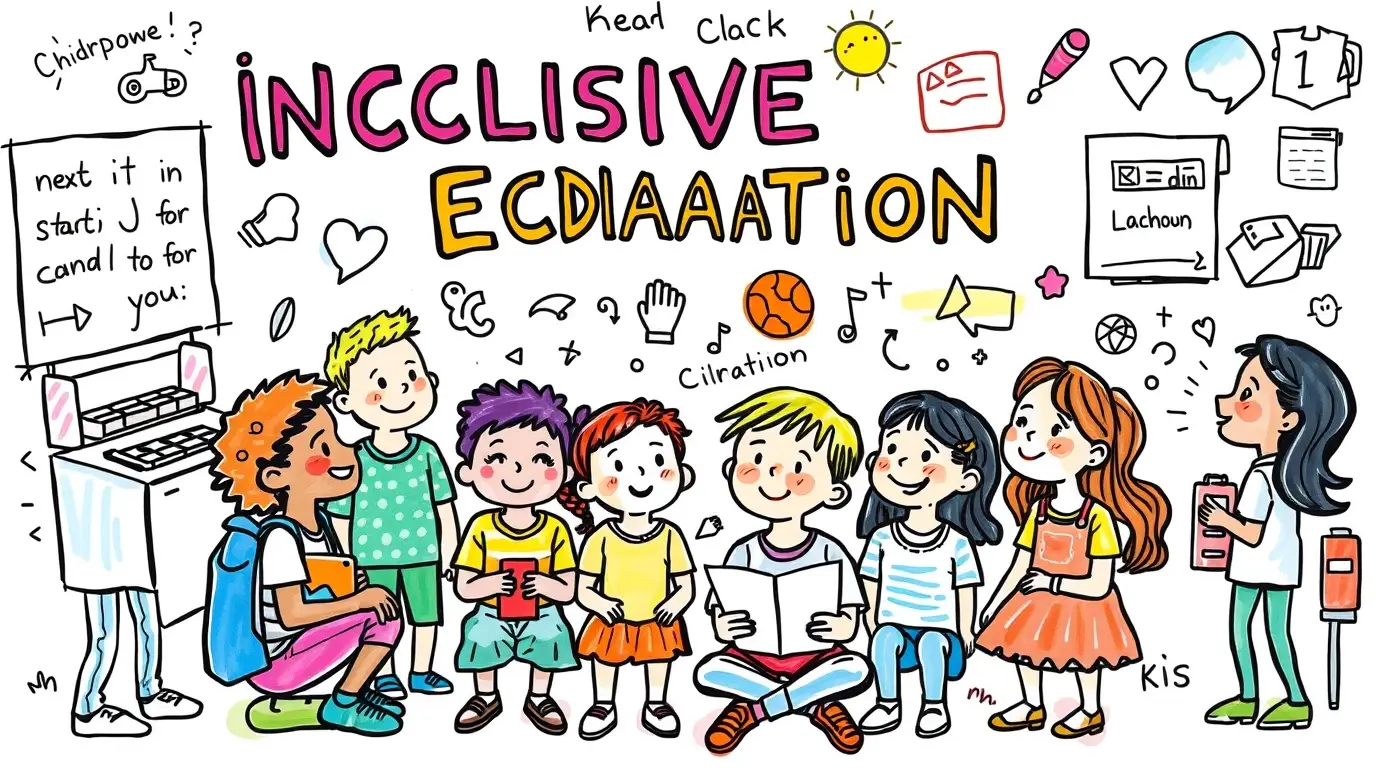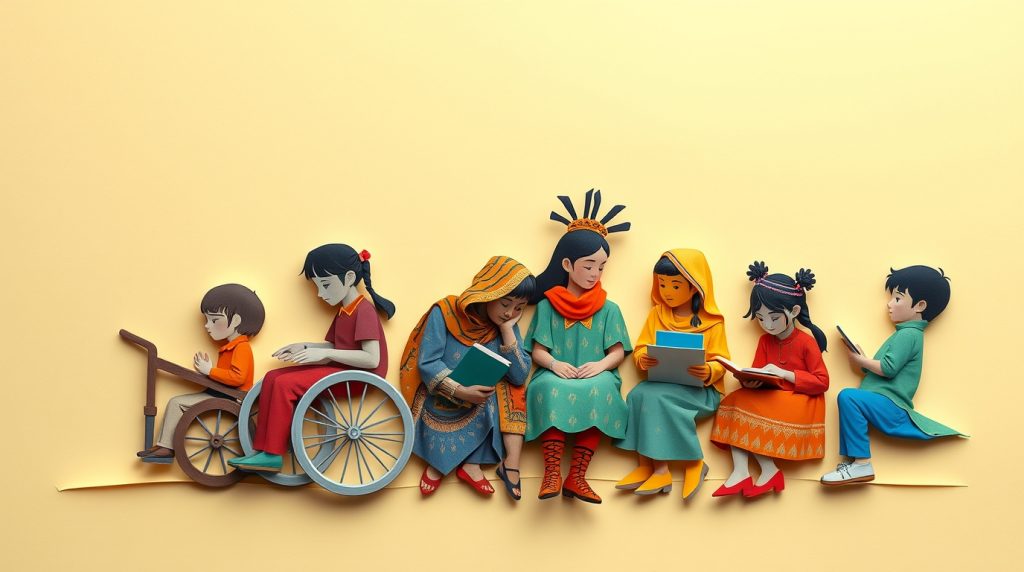Inclusive Education: The Journey of Ultimate Inclusion

What is Inclusive Education?
Inclusive education is a system where all students, regardless of their physical, mental, linguistic, social, or economic differences, have the opportunity to learn together in the same classroom. It emphasizes providing equal educational opportunities for children with special needs, marginalized communities, and students with diverse learning styles. Through inclusive education, every student receives equal opportunities based on their abilities, fostering a discrimination-free, learning-friendly environment.
Why is Inclusive Education Important?
- Ensuring Equality: It guarantees the right to education for every child, allowing them to develop their full potential.
- Social Cohesion: It fosters mutual respect, empathy, and tolerance within society.
- Enhancing Education Quality: Bringing together diverse learners creates opportunities for mutual learning, improving overall educational efficiency.
- Socio-Economic Development: Expanding access to education leads to better employment opportunities and improved living standards, contributing to overall societal progress.
- Empowerment of Students with Special Needs: It integrates children with physical or mental disabilities into mainstream education, enabling them to contribute to society.
Importance of Inclusive Education
Inclusive education is a system in which all students—regardless of their physical, mental, social, economic, or linguistic differences—learn together in the same classroom. It eliminates educational discrimination and helps build an inclusive society by providing equal opportunities for all.
Importance and Benefits of IE
- Ensures the Right to Education for All
National constitutions and international human rights organizations recognize education as a fundamental right. Inclusive education ensures that children with disabilities, disadvantaged groups, ethnic minorities, women, and other marginalized communities are not deprived of education. - Eliminates Discrimination and Promotes Equality in Education
Inclusive education creates a learning environment where there is no discrimination. It prevents negative attitudes toward students based on poverty, gender, ethnicity, or physical disabilities. - Enhances Social Harmony and Cooperation
When students from diverse backgrounds study together, it fosters mutual respect, understanding, and social cohesion, creating an environment of unity and solidarity within society. - Boosts Personal Development and Self-Confidence
In an inclusive education system, every student gets the opportunity to learn based on their abilities and strengths. This helps them build confidence and become more aware of their capabilities. - Increases Employment Opportunities
When students with special needs or from disadvantaged backgrounds receive quality education, they develop skills that make them employable. This increases job opportunities and allows them to contribute effectively to society. - Improves the Quality of Education
Inclusive education follows quality teaching and learning methods that enhance overall educational standards. The opportunity for peer learning fosters analytical and creative thinking among students. - Empowers Children with Special Needs
Often, children with physical or mental disabilities are excluded from mainstream education. Inclusive education integrates them into regular classrooms, helping them become self-reliant and confident. - Fosters a Compassionate and Humane Society
Inclusive education instils empathy, compassion, and human values in students. It plays a vital role in building a society free from discrimination. - Accelerates National and Global Development
Countries that prioritize inclusive education experience greater human resource development and economic growth. A well-educated and skilled population contributes to the overall progress of society and the nation.
How to Implement Inclusive Education in Mainstream Schools?
- Policy and Strategy Formulation: Governments and educational institutions should develop appropriate policies and strategies for the effective implementation of inclusive education.
- Teacher Training: Teachers should be trained in the principles of inclusive education, diverse learning methods, and techniques for working with children with special needs.
- Supportive Infrastructure: Schools should ensure disability-friendly infrastructure, Braille books, audiobooks, and specialized learning materials.
- Involvement of Society and Parents: Parents, communities, and school management should be made aware of the importance of inclusive education.
- Programs and Grants: Governments and NGOs should provide educational materials, scholarships, transportation facilities, and supportive programs for children with special needs.
- Monitoring and Evaluation: The implementation of inclusive education should be regularly monitored, with research and evaluation conducted to assess student progress and make necessary improvements.
- Methods and Tools of Inclusive Education
Inclusive education is a system where all students, regardless of their physical, mental, linguistic, social, or economic differences, have the opportunity to learn together. To implement it effectively, various teaching methods and tools are used.

Methods of Inclusive Education
- Collaborative Learning
Students are encouraged to work in small groups, promoting cooperation and learning. This method helps students with special needs integrate with others and learn together. - Differentiated Instruction
Teaching strategies are tailored according to each student’s learning style and abilities. Some students learn better through visual methods, while others prefer hands-on experiences. Lessons are designed accordingly. - Universal Design for Learning (UDL)
This method ensures that teaching strategies, materials, and assessments are designed in a way that accommodates all students, regardless of their abilities. - Peer Tutoring & Buddy System
Students support and help each other in learning. This system is particularly beneficial for children with disabilities or those who need extra academic support. - Multi-Level Assessment
Student progress is evaluated not only through exams but also through observation, project work, presentations, and practical assessments. - Assistive Technology & Digital Learning
Technology is used to enhance learning, including digital tools, Braille books, audiobooks, speech-to-text software, and online learning platforms.
Inclusive education is not just an educational approach; it is a philosophy of social justice and equity. It ensures that every child, regardless of their differences, gets equal opportunities, acquires skills, and plays a positive role in society.
Tools of Inclusive Education
1. Assistive Technology:
- Braille Books & Braille Typewriters (for visually impaired students)
- Speech-to-Text & Text-to-Speech Software (for students who cannot write or read)
- Hearing Assistive Devices (for hearing-impaired students)
- Adaptive Keyboards & Mouse (for students with physical disabilities)
2. Classroom Support Materials:
- Visual Tools (pictures, maps, charts, flashcards)
- Accessible Textbooks & Audiobooks
- Hands-on Learning Materials (models, simulation kits, etc.)
3. Specialized Learning Software & Digital Platforms:
- MOOCs (Massive Open Online Courses) & E-Learning Platforms
- Customized Apps for Hearing & Visually Impaired Students
- Gamification & VR-Based Learning Tools
4. Environmental Support for Effective Teaching:
- Ramps & Wheelchair Access in Classrooms
- Specialized Seating & Desks (for students with physical disabilities)
- Soundproof Classrooms (to assist students with hearing impairments)
For inclusive education to be effective, appropriate methods and tools must be ensured. Teacher training, student cooperation, digital technology integration, and suitable infrastructure play a crucial role in successfully implementing inclusive education. This approach guarantees that every student, regardless of their differences, receives equal opportunities and quality education.
Teaching-Learning Materials of Inclusive Education
Inclusive education is a system where every student, regardless of their physical, mental, linguistic, social, or economic differences, gets equal learning opportunities. To ensure the effectiveness of this system, appropriate teaching-learning materials are required, which help students of diverse abilities in their learning process.
Teaching-Learning Materials
1. Braille Books & Braille Script
For visually impaired students, textbooks and other learning materials are available in Braille. Braille typewriters and Braille-readable boards help them access education effectively.
2. Assistive Hearing Devices
For students with hearing impairments, hearing aids, FM systems, and sign language interpreters are used. Visual learning tools and subtitle-enabled video content can also be utilized in classrooms.
3. Speech-to-Text & Text-to-Speech Software
- Speech-to-text software helps students who cannot write or read by converting spoken words into text.
- Text-to-speech software is highly effective for visually impaired or reading-disabled students, as it converts written content into audible speech.
4. Easy Language & Large Print Books
- For slow learners, textbooks are written in simplified language.
- For students with low vision, large-print books are used to enhance readability.
5. Visual & Model-Based Learning Materials
- Flashcards, posters, charts, maps, and 3D models help both students with special needs and general students understand lessons easily.
- Interactive boards and multimedia presentations make learning more engaging.
6. Multimedia & Digital Learning Tools
- Multimedia projectors, digital content, and e-learning software enhance students’ engagement in classrooms.
- Audiobooks, video lectures, and touch-screen technology are used for visually impaired students.
7. Adaptive & Specialized Tools
- Adaptive Keyboards & Mouse: Specially designed keyboards and mouse are used for students with physical disabilities.
- Wheelchair-Accessible Classrooms & Ramps: These facilities ensure mobility support for students with movement difficulties.
8. Special Education Software & Applications
- Gamification Learning Apps (e.g., quizzes, interactive games) boost students’ interest in learning.
- Specialized Apps for students with cognitive disabilities, such as Autism Learning Apps & Speech Therapy Apps, support their education.
9. Peer Learning Materials & Buddy System
- Group activities, peer tutoring, and buddy systems are implemented to encourage collaborative learning among students.
10. Multi-Level Assessment Tools
- Instead of relying solely on written exams, alternative assessment methods like assignments, presentations, project work, oral tests, and observation-based assessments are used.
Using appropriate teaching-learning materials is crucial for ensuring inclusive education. These materials enhance students’ learning interests, make the education process more engaging, and provide equal opportunities for every child. By integrating modern technology, inclusive education can be made even more effective.
Conclusion
Inclusive education is not just an educational approach but a powerful tool for building a fair and equitable society. When integrated into mainstream education, it ensures that every individual receives equal learning opportunities, ultimately contributing to a more advanced, humane, and well-structured future.